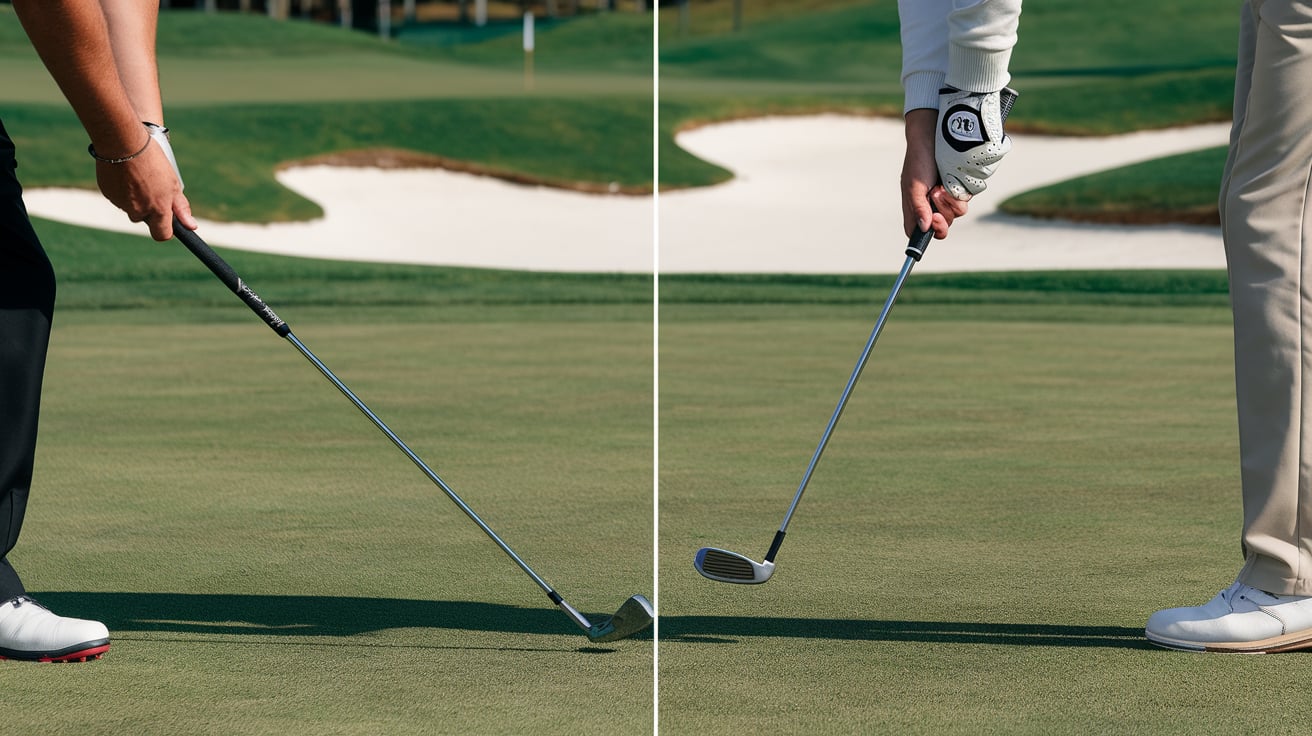The wedge swing and iron swing differ in the level of control and shot placement. Wedges require a more controlled and precise swing to hit the ball close to the flag, while irons are aimed at hitting the green.
Wedges have higher loft angles and are used for shorter shots, pitches, and chips, while irons are used for longer shots. Wedge swings involve a shorter, slower, and more controlled motion, while iron swings are typically more powerful and have a longer follow-through.
The key difference lies in the objectives of the shots and the type of swing required for each club.
Understanding the Purpose of Wedges and Irons
Why Use a Wedge?
-
Wedges are primarily used for approach shots inside 120 yards, chipping, pitching, and bunker play.
-
They offer high loft, allowing for softer landings and greater spin control.
-
Ideal for short game precision and finesse shots around the green.
Why Use an Iron?
-
Irons are designed for longer approach shots, typically ranging from 120 to 230 yards.
-
They offer varying degrees of loft, with lower lofts providing more distance.
-
Essential for hitting greens in regulation and controlling ball flight over distance.
Developing a Strategy for Wedges and Irons
Wedges for Control & Accuracy
-
Prioritize distance control and spin over raw power.
-
Focus on feel and precision, ensuring a smooth, controlled swing.
-
Use partial swings and different wedge lofts to fine-tune shot distances.
Irons for Power & Distance
-
Aim for solid contact with a descending strike to maximize ball compression.
-
Adjust stance and ball position to optimize launch angle and distance.
-
Control trajectory by adjusting swing speed and follow-through.
Key Similarities Between a Wedge and Iron Swing
Grip Consistency
-
The grip remains similar, whether using a wedge or an iron.
-
A neutral grip provides stability and control in both swings.
Wrist Mechanics
-
Proper wrist hinge helps generate spin on wedge shots and power in iron shots.
-
Avoid excessive wrist movement to maintain control and consistency.
Downswing Sequencing
-
Both swings require a well-timed transition from backswing to downswing.
-
The key is maintaining balance and proper weight shift through impact.
Key Differences Between a Wedge and Iron Swing
1. Ball Position Adjustments
-
Wedges: Slightly back in the stance to ensure a crisp, downward strike.
-
Irons: Centered to slightly forward for an optimal launch angle and distance.
2. Stance Width Variation
-
Wedges: Narrower stance to enhance control and limit excessive movement.
-
Irons: Wider stance for stability and increased power generation.
3. Weight & Pressure Distribution
-
Wedges: More weight on the front foot to promote a descending strike.
-
Irons: Balanced distribution, shifting slightly forward through impact.
4. Swing Length
-
Wedges: Controlled and shorter backswing to enhance accuracy.
-
Irons: Full backswing for increased power and distance.
5. Swing Speed Differences
-
Wedges: Slower, controlled tempo for precision.
-
Irons: Faster speed to generate ball compression and launch.
How Club Design Affects the Swing
Wedge Loft vs. Iron Loft
-
Wedges have higher lofts (46°-64°) for high, soft-landing shots.
-
Irons have lower lofts (18°-45°) for lower, penetrating ball flights.
Clubhead Design & Sole Width
-
Wedges feature a wider sole for improved turf interaction.
-
Irons have a thinner sole for a cleaner strike from various lies.
Shaft Length & Weight
-
Wedges have shorter shafts for increased control.
-
Irons have longer shafts to promote higher swing speed and distance.
Mastering Practice with Wedges and Irons
Developing Touch with Wedges
-
Practice half and three-quarter swings for better distance control.
-
Work on spin control by varying ball positions and clubface angles.
Iron Shot Consistency
-
Focus on ball-striking drills to ensure clean contact.
-
Use alignment sticks to refine swing path and accuracy.
Drills for Both Clubs
-
Clock Drill for Wedges: Learn different yardages for partial swings.
-
Impact Bag Drill for Irons: Improve compression and ball-striking.
Keys to Hitting Wedges Consistently
Selecting the Right Wedges
-
Carry multiple wedges (pitching, gap, sand, lob) to cover various distances.
-
Choose appropriate bounce angles for different course conditions.
Carrying Multiple Wedges
-
Each wedge should fill a specific distance gap to ensure proper coverage.
Distance Control with Wedges
-
Use a repeatable swing and proper ball position to control spin and flight.
Knowing Your Yardages
-
Track your wedge distances through practice and launch monitor data.
Sharpening Your Wedge Game
-
Work on bunker shots, flop shots, and bump-and-run techniques.
FAQs
Q: Should you take a full swing with a wedge?
A: Not always. Full swings can be inconsistent. Controlled swings offer better accuracy.
Q: Do you hit a pitching wedge like an iron?
A: Yes, the mechanics are similar, but focus on more control than distance.
Q: Should your driver swing be the same as your iron swing?
A: No, a driver swing is more sweeping, while an iron swing is more downward.
Q: What are some effective drills to improve wedge and iron play?
A: Use a launch monitor to track distances and refine your ball-striking technique.
Conclusion
Understanding the key differences and similarities between wedge and iron swings can drastically improve your short game and approach shots. By adjusting your stance, ball position, and swing speed appropriately, you’ll be able to hit more accurate and consistent shots. Mastering both wedges and irons requires dedicated practice, proper club selection, and strategic shot execution. Now, hit the range and refine your game!

